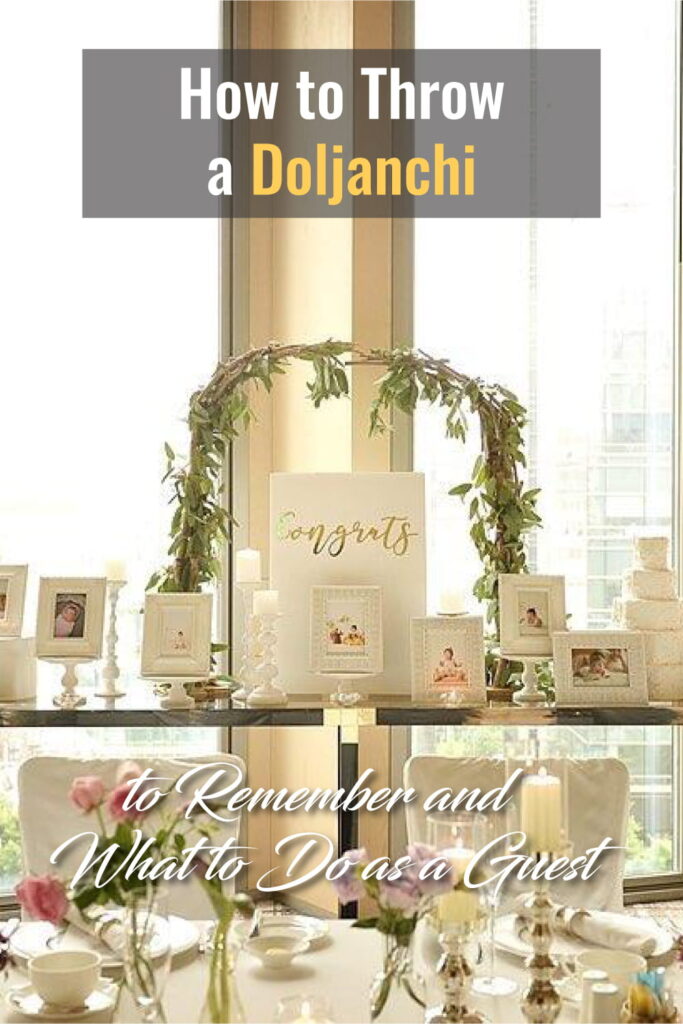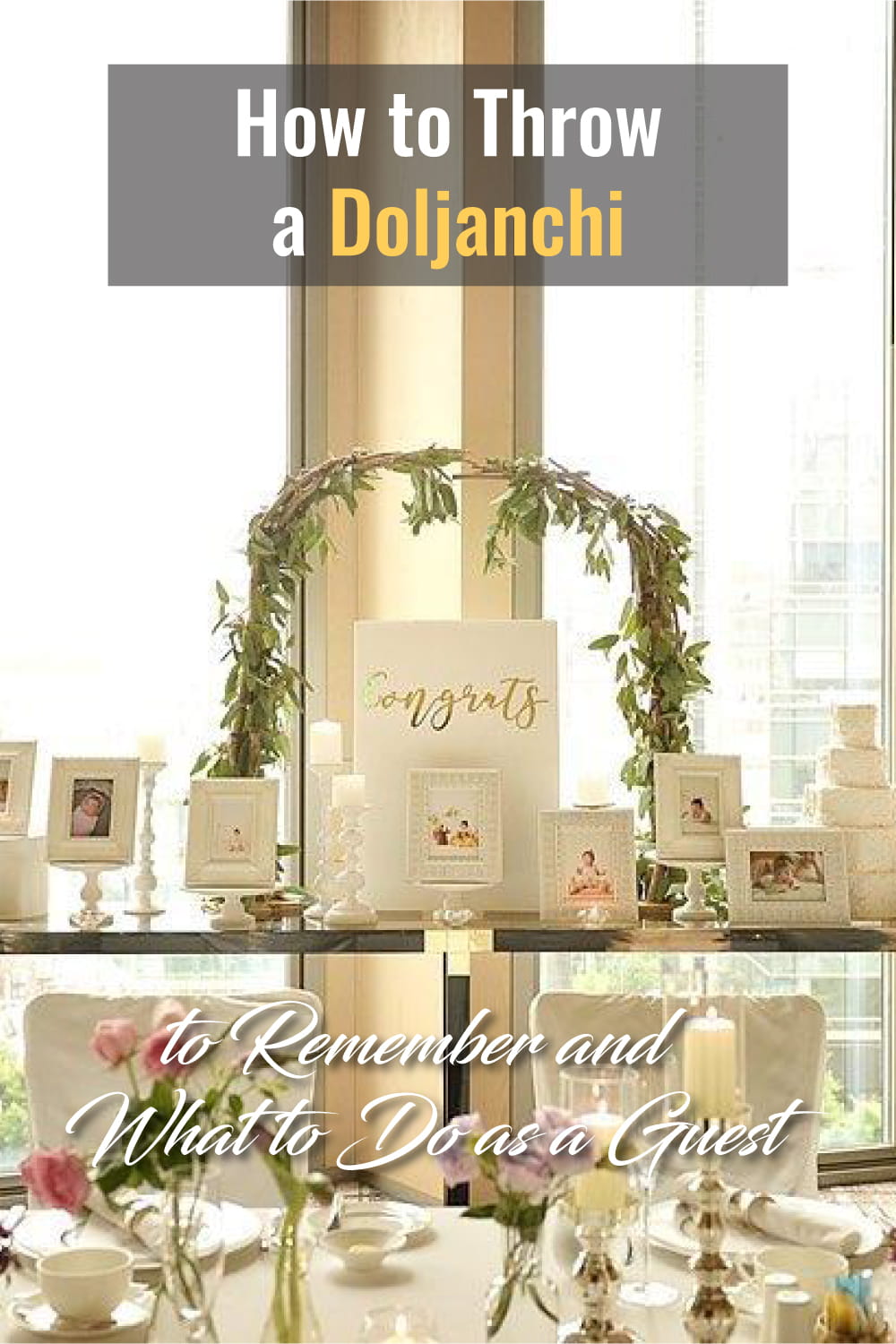In a culture with fun celebrations for babies, doljanchi is the big one.
Whether in the US, UK, Canada or Korea, make the most out of the special day with tips from a doljanchi veteran!
This post includes:
- reason for doljanchi ceremonies
- doljabi
- dolsang
- what to wear and bring as a gift

Key Takeaways
- Doljanchi is a Korean tradition celebrating the first birthday of a baby.
- Doljabi is a Korean custom and event during doljanchi to bless and predict a baby’s future.
- Koreans usually give dol banji (24k gold ring) to close friends or family members as a gift.
What is doljanchi (돌잔치) in Korea?
Doljanchi is a Korean tradition celebrating the first birthday of a baby, and is known for its festive activities such as doljabi and photoshoots.
“Dol (돌)” means the first birthday when a baby turns a “full circle of twelve months”, and “janchi (잔치)” means party or feast. You might also see it written as cheot dol, 첫돌, which also means first birthday
A Korean Dol is traditionally the biggest event and milestone in a baby’s life.

Since others need to attend the party, most doljanchi happen on the weekend before the actual birthday.
Before the pandemic, doljanchi used to be held at fancy buffets or hotel banquets. Now with COVID-19, most Koreans throw a small house party for family members only.
Why do Koreans celebrate doljanchi?


The number 1 reason is a sad one. The infant mortality rate used to be high in Korea, so birth registrations were often delayed.
(Both my parents have different birthdays from their ID cards. My emobu even has a different birth year, so he was happy to retire later than his actual age.)
Once babies made it past the first year, they were more likely to survive longer. So, Koreans have been holding a feast to commemorate this day and pray for the longevity of the child.
Although the infant mortality rate decreased, doljanchi has become even more important due to the low birth rate in South Korea. Most of my friends have one child now or stay DINK.
Doljanchi is a great way to celebrate Korean heritage. It can be held anywhere in the world. There are event planners who can organize a doljanchi in the United States, Canada, U.K., Australia and New Zealand!
But, at the end of the day, all you need is a room, some food and some friends!

What is doljabi (돌잡이)?

Doljabi (돌잡이) is a Korean custom and event during doljanchi to bless and predict a baby’s future.
The birthday boy or girl sits in front of the doljabi kit and chooses one item.
That chosen item is said to determine their occupation among other things. (No one really believes this, and it’s mostly for fun!)
Doljabi items evolve as values or preferred jobs change.
In the past when eating well and living well was the best fortune, the most popular items were rice and yarn.
However, now that everyone eats and lives well, these items are now placed in a corner to lower the chance of the baby grabbing them.
Common doljabi items and their meanings are as below:
- Yarn: Longevity
- Jujube: Prosperous descendant
- Rice/Money: Wealth (Koreans now place debit/credit cards or even foreign currency like US dollars or Japanese Yen. It means the baby will immigrate and make lots of money overseas.)
- Bow (for boys): Police officer or professional soldier
- Book: Scholar or writer (A book in a different language means the baby will be bilingual or multilingual.)
- Pencil: Teacher or professor
- Stethoscope: Doctor
- Microphone: Celebrity, reporter, singer, etc.
- Gavel: Judge, prosecutor, lawyer, etc.
- Calculator: Career in finance
- Sporting Goods: Athlete (Items vary depending on famous athletes of the time. Golf ball during Se-ri Park’s era, baseball when Chan-ho Park was big, and figure skating boots when Yuna Kim was the talk of the town)
- Mouse: Computer guru
- Camera: Movie director, photographer, etc.

How to host a doljanchi?
Here are some general guidelines, but feel free to make it your own special way!
- Duration: 2 hours
- Number of guests: 8-50
- Location: house or hall, depending on number of guests
Optional: Korean parents love doing a dol photoshoot at a studio beforehand, and displaying lovely pictures of their baby at the party. You can also frame the best photo and hang it in the wall to remember this moment forever.
Step 1. Find the right venue
For smaller celebrations, you can use your house, an apartment clubhouse or community center.
For something more grandiose, you can rent out an event hall and hire an event planner.
Optional: Hire a photographer to capture the magic.
Step 2. Prepare a Dolsang

Dol of course means first birthday and sang means table in Korean. A dolsang can be any kind of table, there are usually a few as shown above. Some smaller round ones on a long rectangular table is a classic look.
For some more ideas, ask at your local upscale Korean restaurant or check out Etsy.
You can decorate it however you want!
Most Koreans place fruits, rice cakes and a cake on one round table, and a doljabi kit on the other.
Step 3. Invite your guests
For smaller gatherings, immediate family such as parents, siblings and grandparents will do.
For larger gatherings, anything goes depending on your budget and size of your venue. In Korea, people will invite their coworkers and acquaintances.
Some of your guests will have toddlers, so having some high chair alternatives handy will be a good idea.
Step 4. Welcome guests
It’s tradition to wear either hanbok or formal clothes like suits and dresses, have a small table set up with bowls representing each doljabi item and greet guests one by one as they arrive.
Guests will take a number on something like a raffle ticket, tear it and place half in the item bowl they think the baby will choose.
Optional: Hire an MC to conduct the event and have a video playing of the baby’s first year.
Step 5. Have the meal
For smaller gatherings, you can provide a course meal.
Buffet style meals are common for larger doljanchi.
Step 6. Light the cake
Light the big cake and sing happy birthday together. Then, have the parents blow out the candle. (This sometimes happens before the meal in Korea.)
Optional: Have a bakery in Koreatown design the cake.
Step 7. Hold the Doljabi
Now the highlight of the doljanchi event. Everybody cheers for the baby to grab an item by yelling jabara (잡아라 or “grab”).
There will be a raffle or lucky draw after doljabi with the number each guest took at the beginning. A parent picks one person among the guests who guessed the right doljabi item. A common gift in Korea for this is a Starbucks or department store gift card.
Optional: Have multiple rounds of lucky draws for long-distance prize (for the guest who traveled the furthest distance), and lucky seat prize (random number among all the leftover raffle tickets)
Step 8. Thank guests and give out presents
Finally, after a few hours, it’s time to say farewell to your guests. You can do this by handing out the thank you presents.
Optional: The most common doljanchi gift for guests is a towel with customized embroidery of your baby’s birth date. Bonus points for having a cute animal character that matches their zodiac sign (띠)!
Get your Doljanchi checklist here!
How much should I spend on hosting a Doljanchi?
There’s no hard and fast rule. You can host an unforgettable occasion that costs as much as a wedding, or you can just invite a few close friends and family members to your home.
In Korea, it’s common for people to throw bigger events and invite their boss, coworkers and extended family. Doljanchi is more than the baby’s first birthday, it’s a reflection of one’s standing in society.
If you’re living in the states, there’s less expectation to have a huge event. You can keep it casual and use the clubhouse, recreation or community center in your neighborhood.
There’s no cultural pressure to go big, just social! If you want to make it a day to remember, you can always hire a party planner and photographer.
How to find a Doljanchi planner in my country?
Whether you want to rent a venue, get a cake, find hanbok and hire a photographer yourself or have an event planner do everything, there are businesses all around the world that can help.
The number of service providers goes up with the concentration of Koreans. For example, Los Angeles has many full services event planners whereas somewhere like Dallas has a few bakeries that do custom cakes for doljanchi.
When in doubt, ask at a Korean restaurant with private rooms.
U.S.A.
Details Details
18 Technology Drive #124
Irvine, CA 92618
949-600-8881 (Orange County, CA)
310-870-0390 (Los Angeles, CA)
858-880-9389 (San Diego, CA)
Leafy Party
8730 Wilshire Blvd #101
Beverly Hills, CA 90211
310-360-7241
Dana Yu Creative
37 Amos ST
Sleepy Hollow, NY 10591
Serving the entire New York Metro area
The Party New York
Greenport, NY 11944
712-441-6269
Bat Haus (venue & event space)
459 Grand St
Brooklyn, NY 11211
Williamsburg – North Side
917-865-8660
Table Concept
Flushing, Queens, NY
917-613-2117
Party N Favors
11434 Emerald St, Dallas, TX 75229, USA
214-725-6519
The PN
11127 Shady Trail #105 Dallas, TX 75229
214-729-2675
Mozart Bakery
11420 Emerald Street
Dallas, TX 75229
972-406-8885
Texas Rose Bakery
Austin, TX 78753
512-565-4935
Hansang Dolsang
Columbia, MD
443-315-9919
Chookha Party
12627 Jedburg Ln, Woodbridge, VA 22192
703-705-1501
Canada
Dodam Dodam
Toronto, Canada
647-264-2828
Party with Chloe
Toronto, Canada
647-472-5333
The Party Ave
Vancouver BC, Canada
U.K.
Merry Days London
London, UK
074-4618-6841
Elizabeth Atelier
London, UK
075-0717-8558
Australia
Bebe Story
2 Monak Street, Rucorn, QLD 4113
0401-455-390
Lim Hanbok
Eastwood Eastwood, NSW, Australia 2122
424-350-456
New Zealand
Petit et Maman
Botany, Auckland
02102606564
2bmumnz
Glenfield, Auckland
What to bring as a gift when you’re invited to doljanchi?

It depends on how close you are to the parents of the baby.
Koreans give “dol banji (돌반지 or 24k gold ring)” to close friends or family members.
Why a gold ring you may be wondering?
Times were tough in old days and gold is always handy in a pinch. It was considered a good way to pay for college or emergencies. Apparently, I have a bunch of gold rings lying around somewhere, but I’ve never seen them!
For everyone else, just give cash in an envelope. Best gift ever.
| Relationship | Amount |
| Acquaintance | 30,000 to 50,000 won (30-50 dollars) |
| Coworker | 50,000 to 100,000 won (50-100 dollars) |
| Close Friend | 100,000 to 200,000 won (100-200 dollars) |
| Relative/Family | 200,000 won or above (200 dollars or above) |
What to wear to doljanchi?
The dress code should be neat, somewhere between formal and casual.
- For men: Suits are standard in Korea, but business casual attire is also recommended.
- For women: Dress or blouse with skirt or trousers are nice for doljanchi.
Stylish Korean Outfits Perfect for Doljanchi
Since doljanchi has a lively atmosphere, navy, charcoal or bright colors are fitting, rather than all black like a funeral.
But what if I want to wear hanbok for fun?
Wearing hanbok without being part of the immediate family is akin to wearing white to a wedding. It will seem like you’re trying to overshadow the parents. It’s just not done.

What to give guests if you’re hosting doljanchi?

In order to show gratitude to those attending your baby’s doljanchi, most Koreans give dab-lye-pum (답례품 or a return gift) to guests.
High quality towels with embroidery are the most common gifts in Korea. Note the aforementioned cute zodiac character (my friend’s baby was born in the year of the mouse).
Also, rice cakes, mugs and soap are good as a small token of gratitude.
FAQ
What do Korean children wear on their first birthday?
Korean kids wear hanbok on their first birthday. They also get to don snazzy hats called jobawi (조바위) or gulle (굴레) for girls and a bokgeon (복건) or hogeon (호건) for boys.
You’ll be asking if they come in adult sizes.
What is the conception dream in Korea?
It’s called 태몽 (taemong). Every Korean knows which taemong their moms had for them. Most Korean women have taemong, but sometimes their husbands or even parents do as well.
Some pregnant women say they dream of:
- fruit (apples, persimmons, cherries, chestnuts)
- animals (tigers, snakes, goldfish)
- nature (rivers, rainbows)
- children
- jewels
Koreans also think that the type of dream can predict the gender of a baby. (We don’t truly believe it, it’s just for fun.) For example, a dragon or tiger means they will have a son.
Interpretation may be tricky if you dream of a peach though. Many small peaches mean a daughter whereas one large peach means a son.
What’s the difference between baegil (100-day celebration) and dol (1st birthday) for Korean children?
The historical reason for baekil janchi (백일 잔치) is similar to that of dol janchi. Initially, baekil janchi celebrates the baby’s survival in spite of frequent infant deaths. (FYI, Korean couples also celebrate their 100-day anniversary.)
Nowadays, baekil janchi is somewhat simplified with commemorative photo shoots and meals with the family. Some parents still order a box of rice cakes (susupattteok or baekseolgi) and share them with family, friends and acquaintances.
Subscribe for
exclusive info on Korea
Did we miss anything?
Let us know your thoughts or questions about doljanchi in the comments!




